During Springtime in Seville, southern Spain, Feria, a week-long celebration takes place. It draws over one million people a year. Called in Spanish “La Feria de Sevilla” or “La Feria de Abril”, literally meaning the Seville’s Fair or April Fair. It begun in 1847 as a cattle trading fair. Over the years Seville’s April Fair has become an internationally known celebration of flamenco, bullfighting and fun. Flamenco is an integral part of Feria tradition, since Seville is considered epicenter of flamenco culture and music. Many of the flamenco’s most famous artists, songs and composers are from this city.

Seville-Horses
The Andalusian capital’s April festival traditionally begins two weeks after Easter, which means it can fall in May, despite its name. The banks of the Guadalquivir river are covered in rows of casetas. These are decorated tents, set up by families, clubs, trade associations and political parties. Here crowds gather to socialize in to the night.
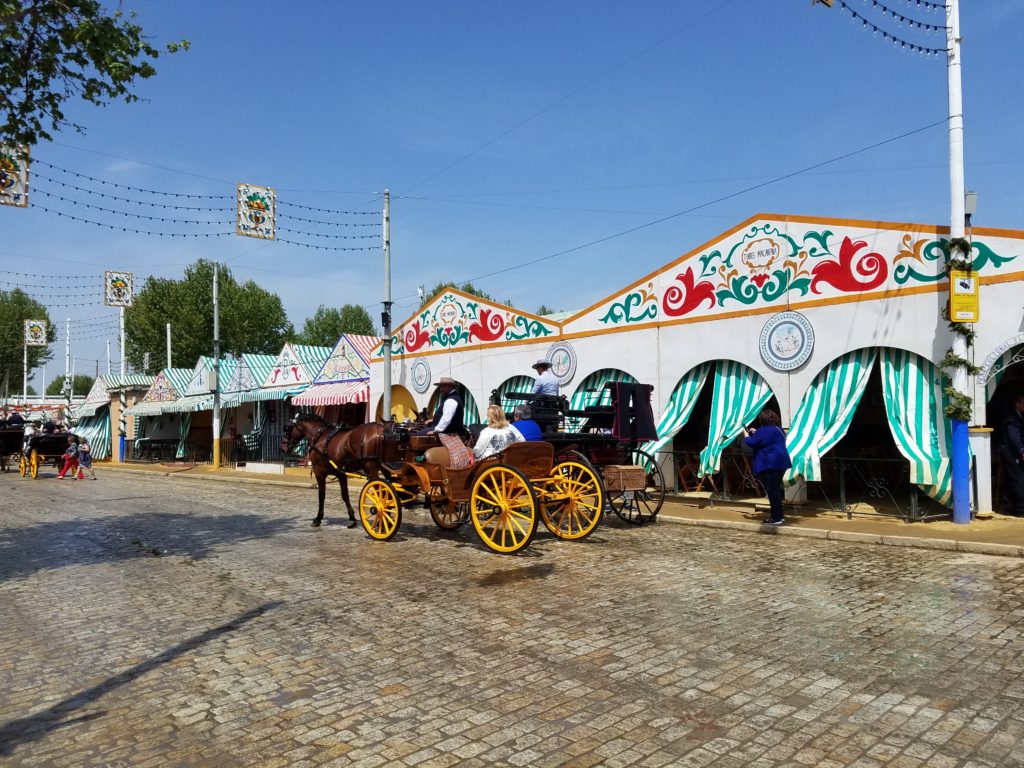
Tents at Feria
We were lucky to be able to coordinate our visit to Seville, Spain with the Feria, and got to experience this magical time.
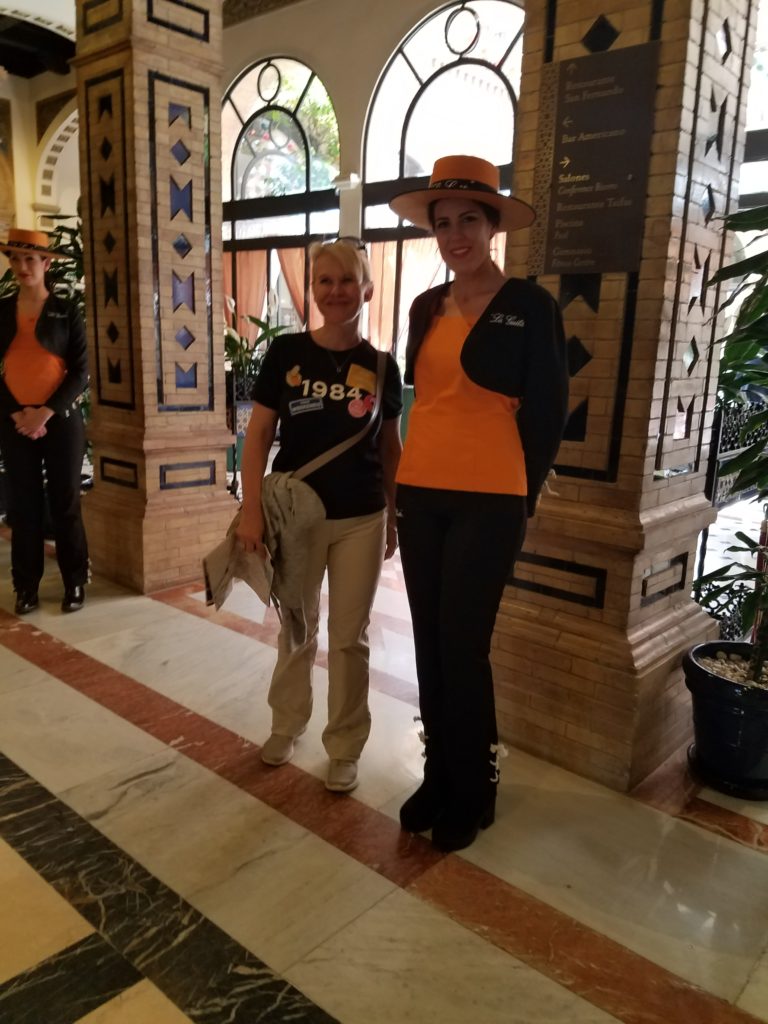
Hotel Alfonso XIII during Feria
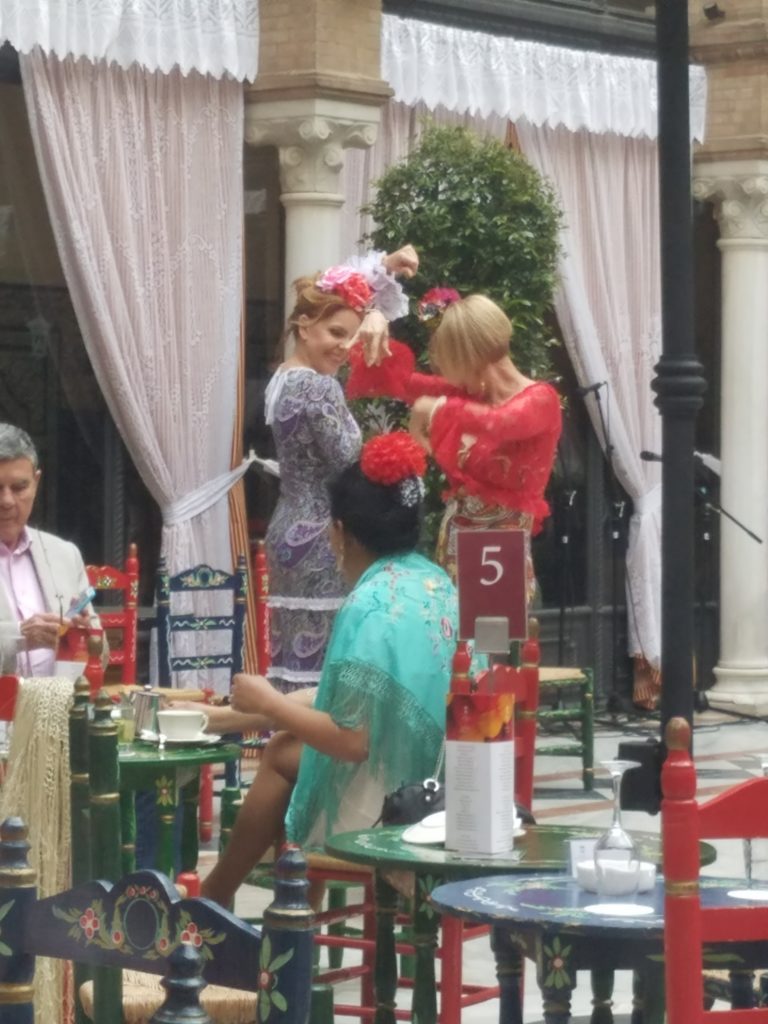
Locals dancing Flamenco at AlfonsoXIII
Now let enjoy it together!!
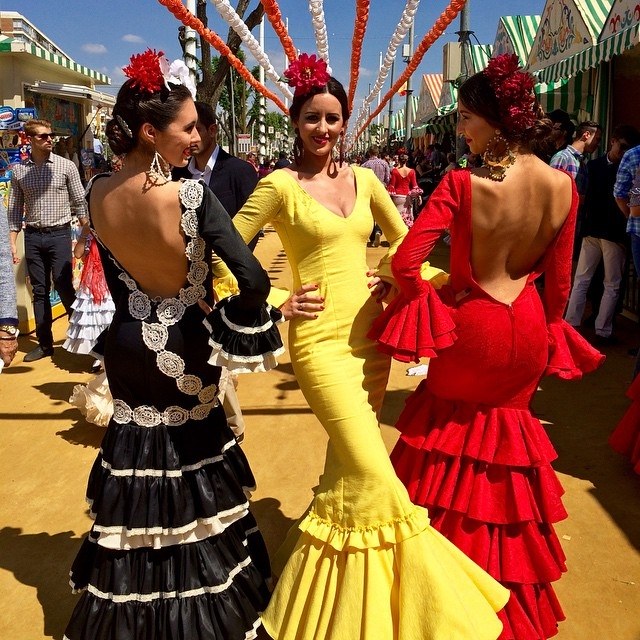
seville-april-fair
Location

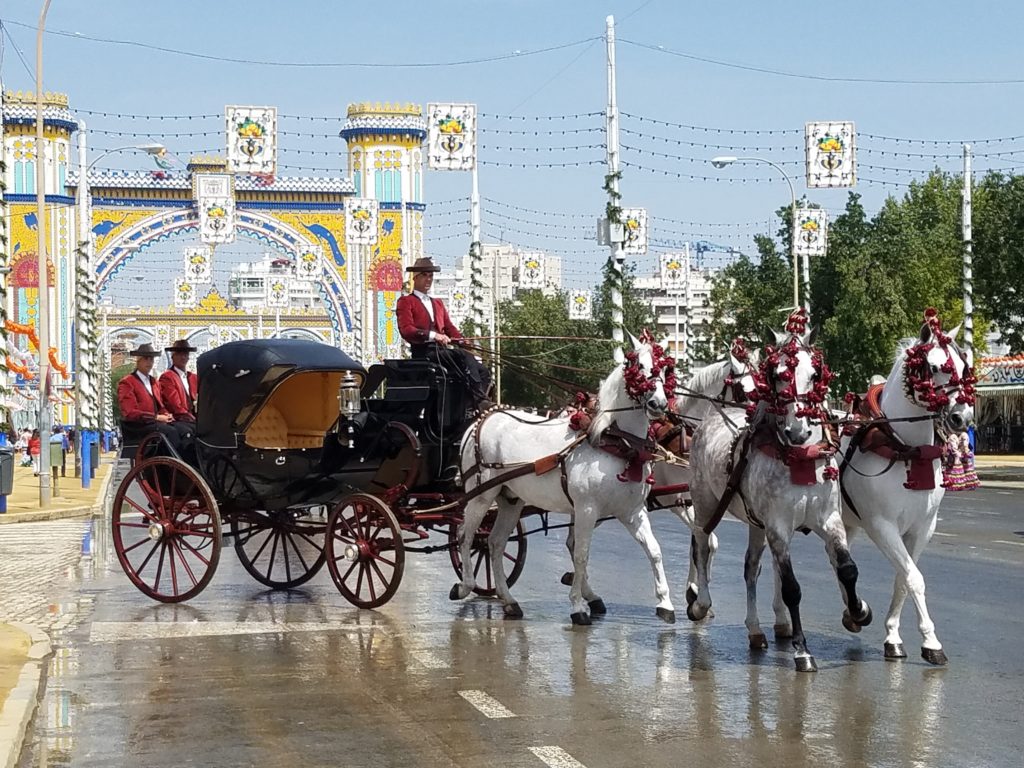
Real de la Feria
Real de la Feria, where the Feria takes place, covers 1 square mile and includes the amusement park, `called ´Calle de Infierno’ (Hell Street), and the casetas, canvas tent pavilions of varying sizes arranged along 12 streets. Numbering over 1,000, they belong to eminent local families, groups of friends, businesses, clubs, trade associations and political parties. Most of the casetas are private and open only to members and their guests. If you have a Sevillano friend with a caseta, you could be lucky enough to receive a much-coveted invite. Alternatively, there are also seven public casetas – the “caseta municipal” and one for each of six districts of Seville.

Feria-Seville
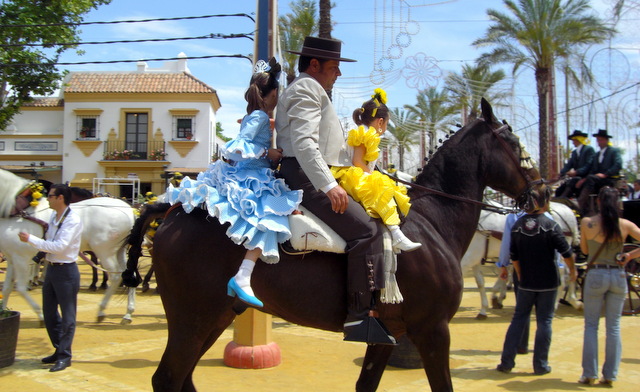
Family-feria
Feria De Sevilla Calendar
Every year Feria follows a strict traditional calendar. It starts exactly 2 weeks after Easter Sunday.
Monday:
Members’ meeting at the casetas and start inauguration of the Feria de Sevilla with a dinner called el Pescaíto (slang for “small fish”). At midnight the Major turns on the lighting, including the entrance arch known as la Portada and thousands of colorful farolillos (paper lanterns) as well. This ceremony is called el Alumbrado.
Tuesday:
Most lunches and dinners are organized this day for friends, coworkers and businesses. The lights are on until 3:00.
Wednesday:
It’s the main day of the Feria de Sevilla. The lights are turned off at 4:00.
Thursday:
Usually the number of people attending increases significantly. You can also see a lot more horses and carriages. The Feria is lit up until 5:00.
Friday:
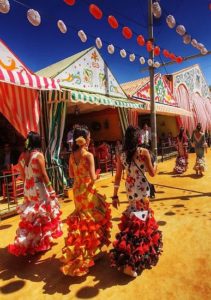
Sevilla-Spain-Feria
As the weekend arrives, the number of visitors rises and you’ll have the chance to see a lot of celebrities, toreros, members of the nobility and politicians. The crowd can reach up to a million people.
Saturday:
It’s generally the second most popular day. The lighting is on until 6:00.
Sunday:
The last day of the Feria is mainly devoted to bullfights. La Maestranza bullring hosts a corrida with the Miura stock breeding, famous for their enormous size. At midnight the Feria de Sevilla holds the closing ceremony with lots of fireworks next to the Guadalquivir river.
If you can’t spend full week in Seville during Feria, last 3 days are the best, but also most expensive.
How to fully enjoy Feria:
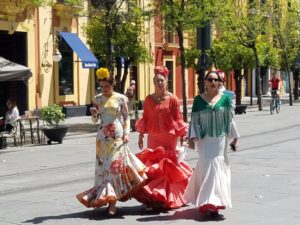
Feria-Streets-of-Seville
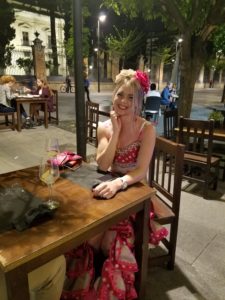
Feria-Restaurants-Saville
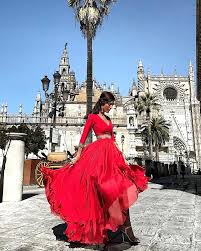
Seville
Although there is a specific area designated for the Fair, Feria is truly celebrated around whole city of Seville. All restaurants, bars and hotel will be full of the locals dressed up in traditional Flamenco dresses and proper jackets as the go to and come from Real de la Feria . Parties will take place in many venues outside of proper fairgrounds.
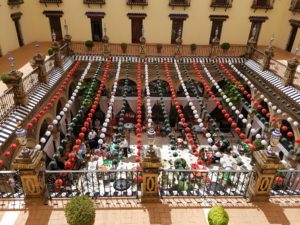
Alfonso XIII-Feria
At our Hotel, Alfonso XIII, a Luxury Collection Hotel, lobby and courtyard were decorated in same fashion as the most exclusive tents at Feria, with Flamenco band, and locals dancing together.
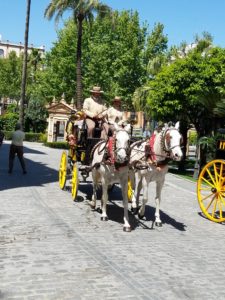
Alfonso XII- Feria
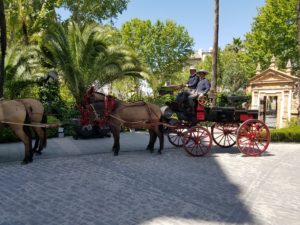
Alfonso XII- Feria
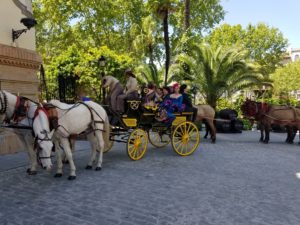
Alfonso XII- Feria
Luxury cars that usually are parked in front of the hotel, were replaced with richly decorated carriages, and chauffeurs replaced with dressed up coachmen.
If you are a equestrian fan, you will be enchanted by most beautiful horses, dressed up as much as their riders. After all Andalusian stallions come from here.
But for the full experience of Feria, let’s head across the river to Real de la Feria.
Real de la Feria (Fairgrounds):
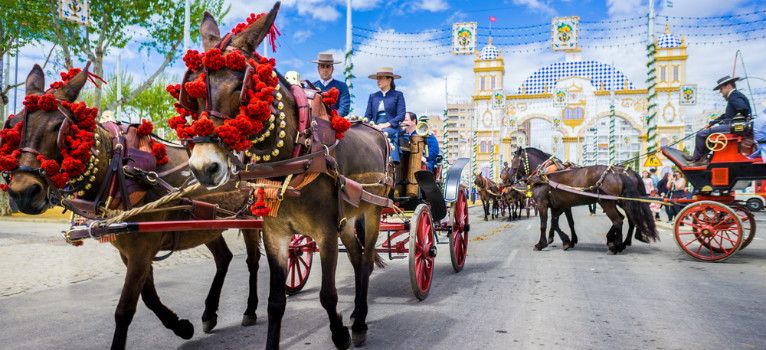
April-Fair-in-Seville
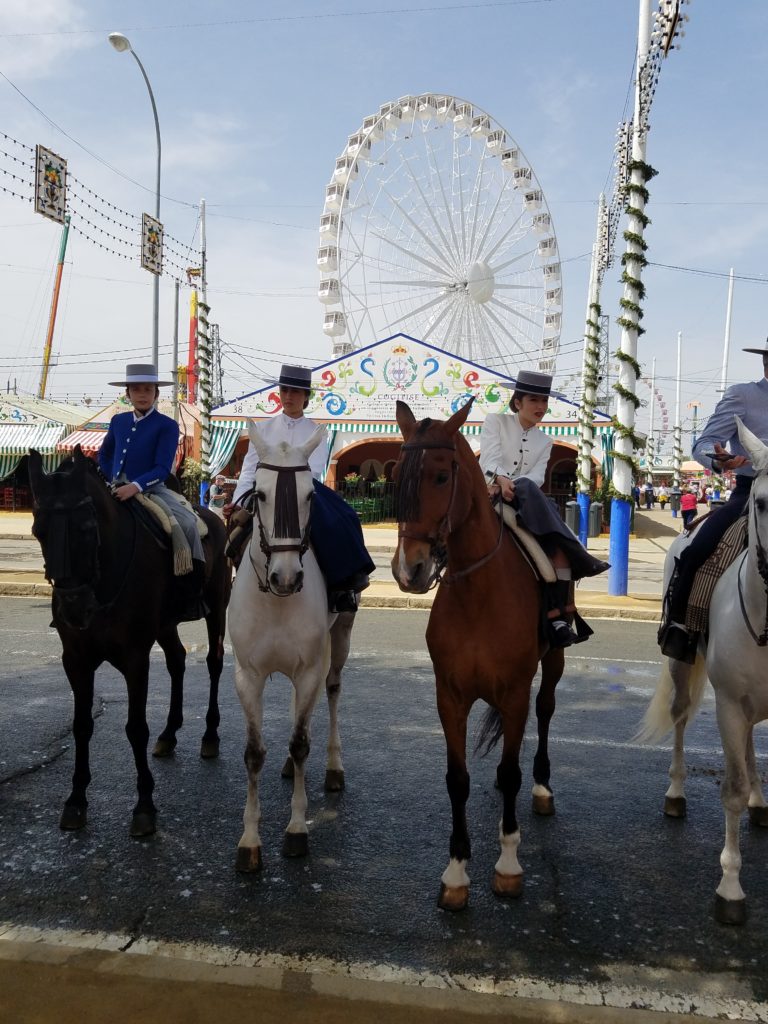
Calle de Infierno
As I wrote before, the Seville Fair mainly takes place in the fair zone called the Real de la Fería. Along the Guadalquivir River a temporary “tent city” is born on a rectangular piece of land, that measures one mile by 700 yards. The makeshift “tents” or as they are known in Spanish “casetas” divide the land into different dance halls and private areas. They are filled each evening with dancing and life, lasting from 9 in the evening until 6 or 7 in the morning. The women are known to dress in their most spectacular gowns, usually brightly colored flamenco dresses inspired by Gypsy fashion.
Manzanilla and Rebujito
The most common beverage drunk in during the Seville Fair is Spanish sherry wine, Manzanilla , very famous in southern Spain. Often, to battle the heat of April in Seville, the sherry wine is mixed with 7-up or sprite to produce a drink known as “rebujito“.
Casetas
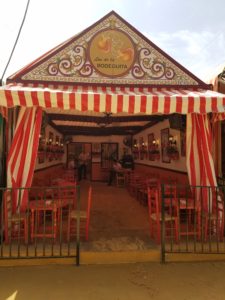
caseta-Feria
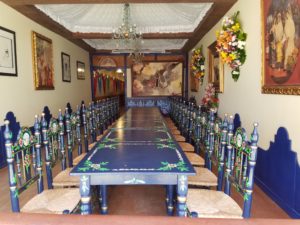
caseta-Seville
The casetas, or tents, are usually hosted by wealthy families from Seville, nightclubs, trade unions, political parties, or city organizations. Every tent is set up differently with a unique atmosphere and different customs. Access to most of the tents is on an invite only basis but some are open to the public so that the many tourists and locals who do not have connections in high places can still enjoy the April Fair. Visitors roam around the fairgrounds until they find an open tent with a good vibe to have a drink, watch performances and experience the atmosphere.
A well known caseta is called “Er 77” and is famous for pouring wine from buckets and having cots available for naps. The “Los Duendes de Sevilla” (The Goblins of Seville), named after a painting by Alvarez Quintero, is another famous tent in Seville’s Fair. There are many other different themed tents from various groups including left wing politics, anarchists and much more.
Family attractions
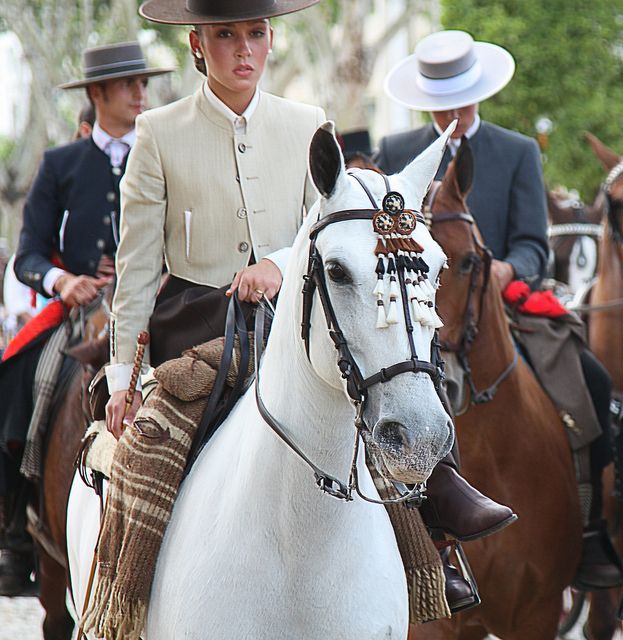
horseback-feria
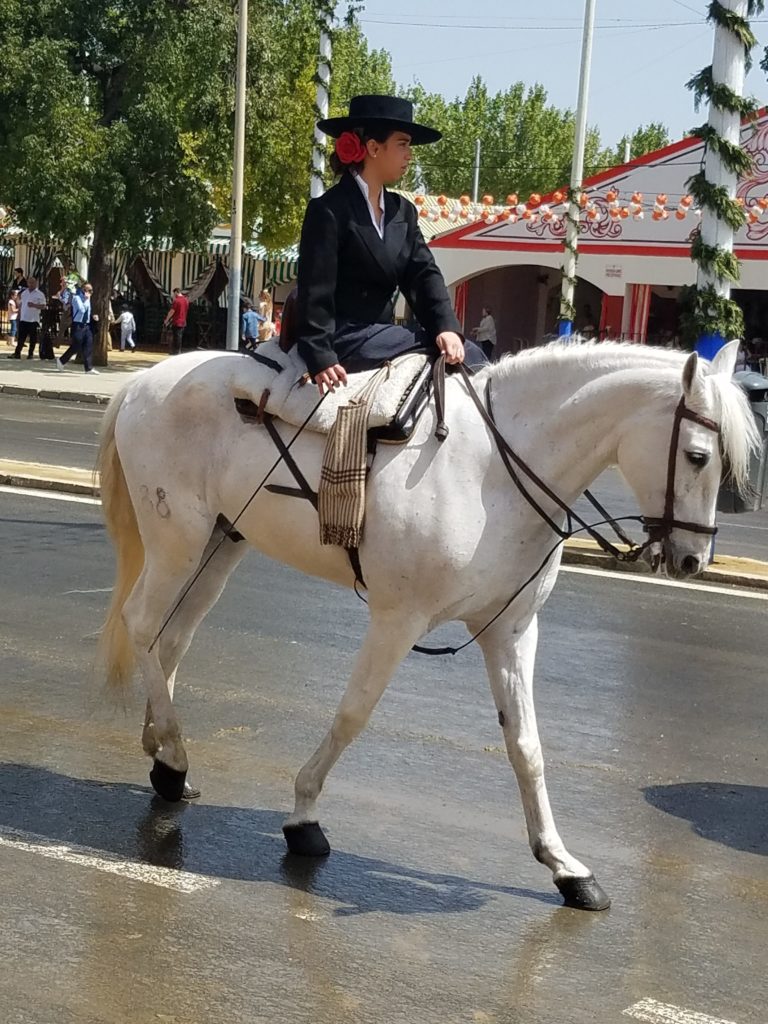
Rider-Seville
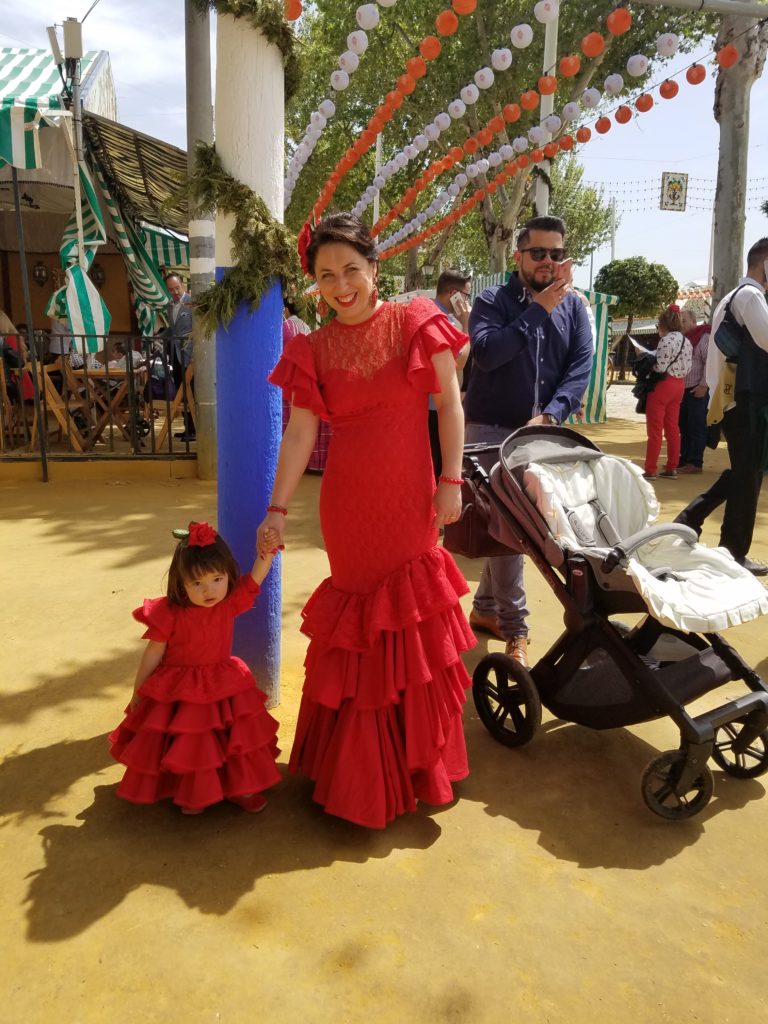
Family-at-the-Fair-Seville
In addition the long nights of stomping, clapping and celebrating in the casetas, La Feria de Sevilla also offers a wide range of other events during the day. Andalusian horse parades with decorated carriages are daily processions as they make their way through the city and fairground. The equestrian events are usually accompanied by singing groups who serenade crowds with traditional Sevillian ballads and guitar music. Many of the parade participants are members of Seville’s upper class aristocracy and normally dawn exquisite traditional Andalusian outfits with wide-brimmed “bolero” hats and short-cropped jackets.
Carriages and Horses
The carriages are the only vehicles allowed inside the fairground (except for ambulances and police cars). This tradition dates back from the 1850s. People used to arrive and return from the Feria de Sevilla – a livestock fair then, to deal with breeders that used their own carriage.
Fortunately, this custom remains and you’ll have the chance to see the most beautiful horse carriages in Spain. There is a tradition of strong rivalry between carriage owners on most elaborate decorations. Don’t miss the carriages themselves as well as the horses’ ornaments. And of course, the costumes of the drivers and passengers. Everyone is dressed with the traditional gala clothing and it’s absolutely spectacular.
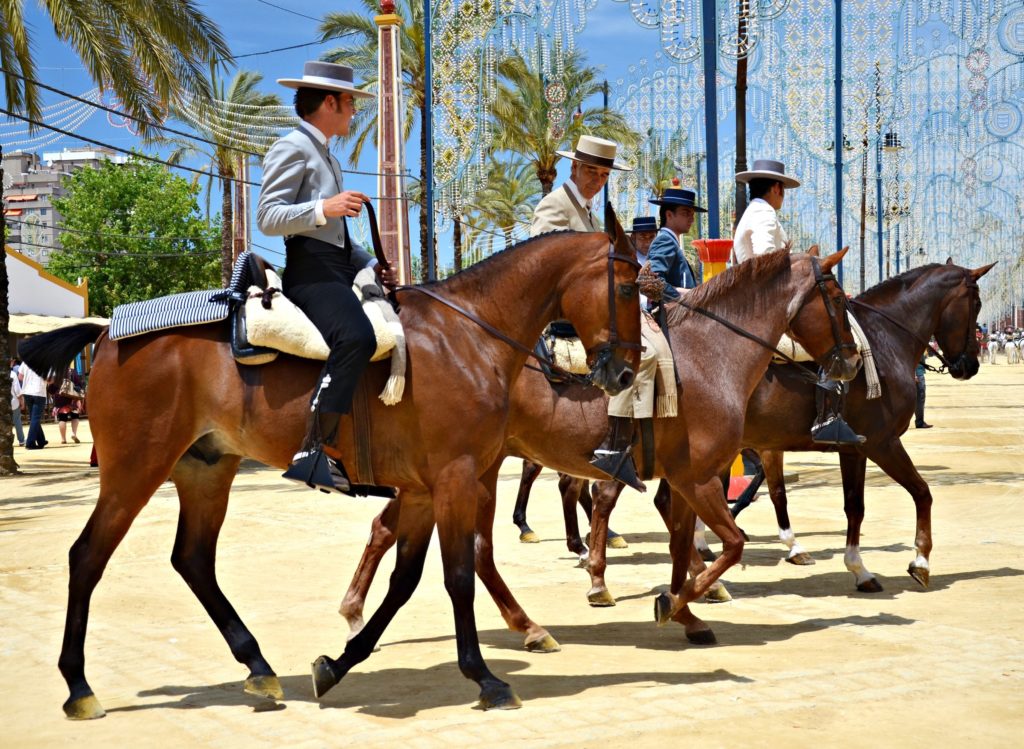
Horseback-Seville
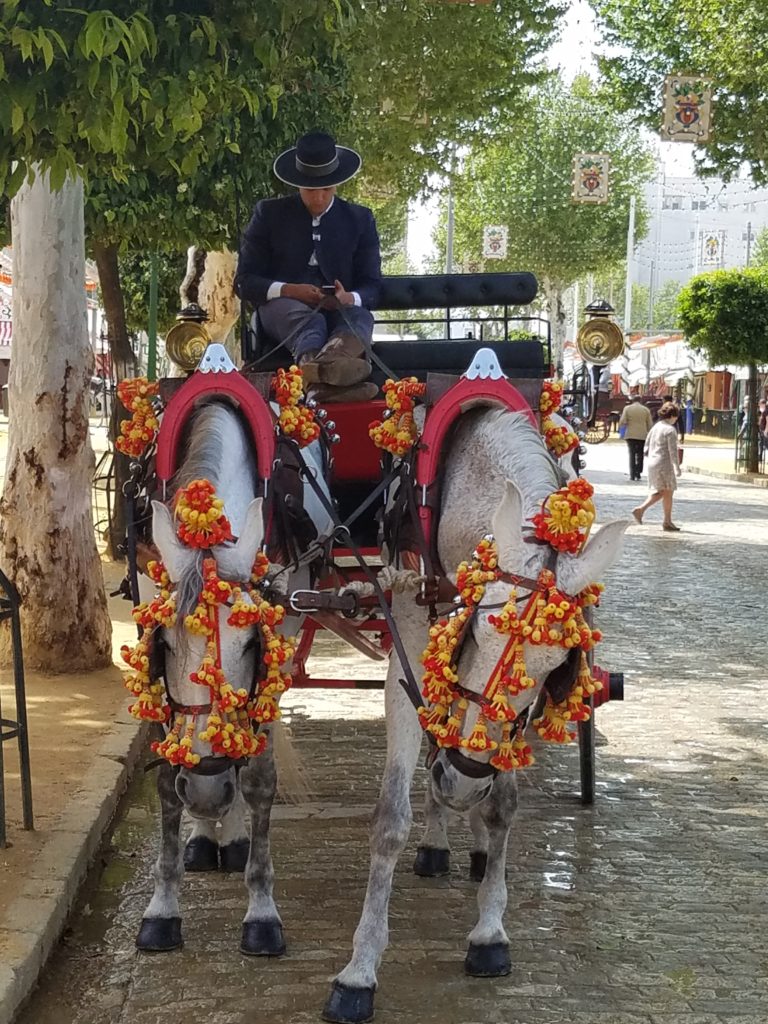
carriage-Seville-Fair
Corrida at La Maestranza
For locals and many tourists alike, not to be missed during the April Fair are the afternoon bullfights. The Seville Fair draws top-name bullfighters from all around Spain. The bullfights here are considered some of the best of the year. The bullfights take place at 5:30 pm in the Plaza de Toros de Maestranza.
The bullring in Seville is known as one of the most beautiful in Spain and is commonly known by the locals as “the cathedral”. For visitors to Seville during the Feria, tickets can be purchased directly at the bullring. However, due to the huge draw of the event, tickets can be very expensive.
I’m not a huge fun of bullfights, but if you are interested in going, purchase tickets way in advance.
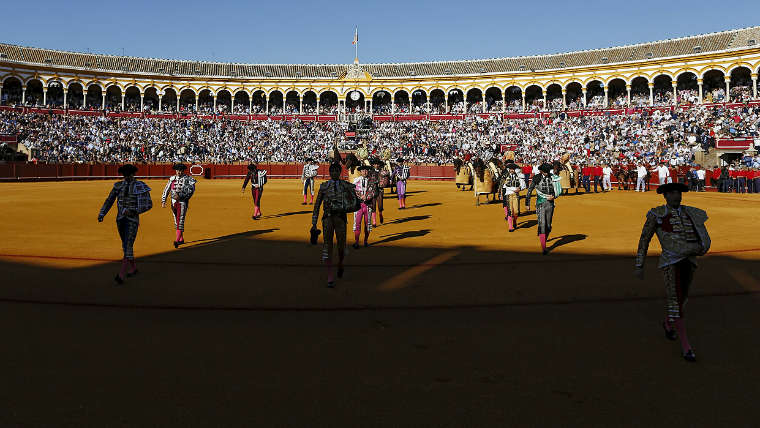
Corrida-Feria-Seville
As you can see, words can hardly explain how beautiful and special La Feria de Sevilla is. Tourists pay premium to see flamenco dancers when they come to Spain, and then go to a separate show to see Andalusian Stallions. During Feria the whole city of Seville becomes one giant live show of quintessential Spanish experience that you get to enjoy, and participate in for free!!

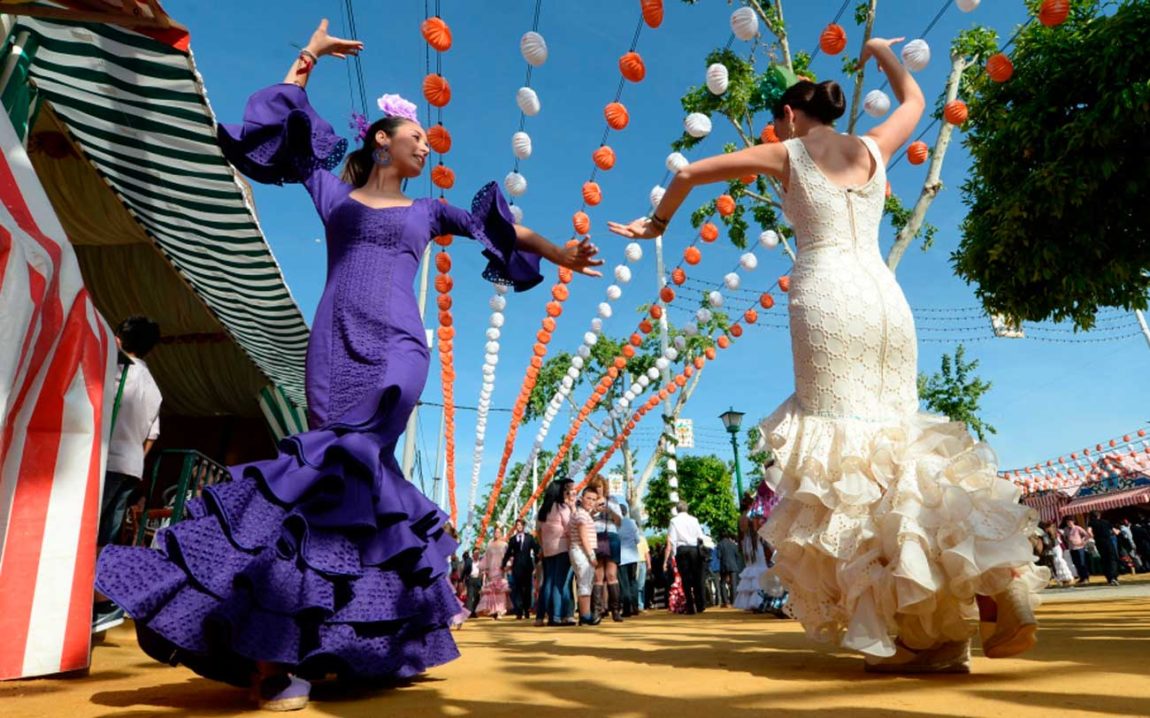
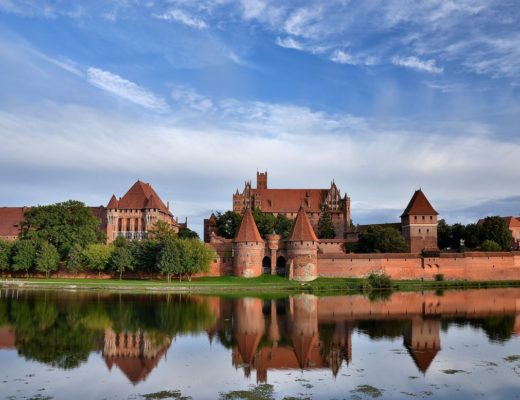
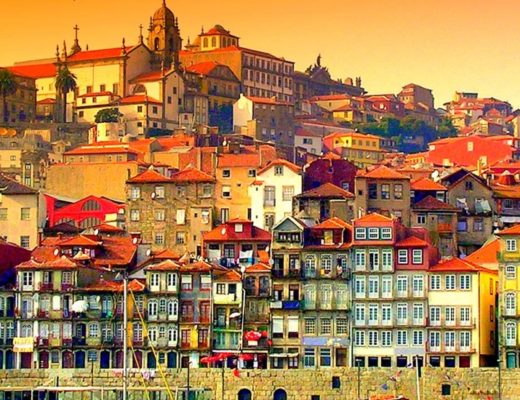
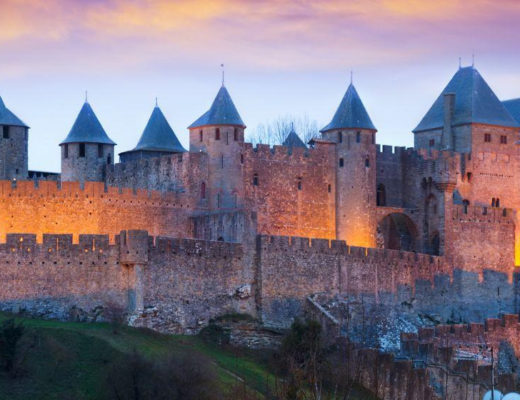
Review: Hotel Alfonso XIII, a Luxury Collection Hotel, Seville, Spain - PointsTravels
August 2, 2018 at 10:32 am[…] Seville’s gardens are about 0.5 mile away. Unless you are going somewhere across the river (we went to Real de la Feria, where Spring Fair takes place), you will never need to take a […]
Perfect 2 Days in Seville, Spain: Columbus, Carmen, Cathedral, Alcázar, Torre del Oro, Plaza de España and more - PointsTravels
August 4, 2018 at 12:03 pm[…] After walking through the gardens we headed across the river to partake in Seville’s most magical festival La Feria de Sevilla. I wrote a separate article-post about it. Please feel free to click the link below to read it. CLIC… […]